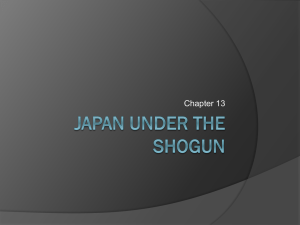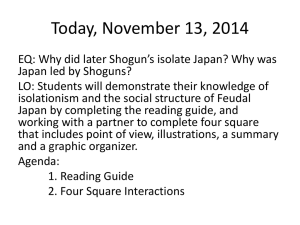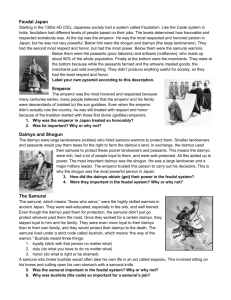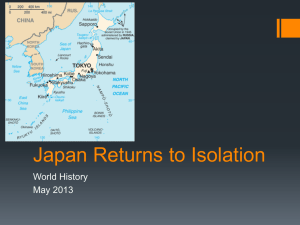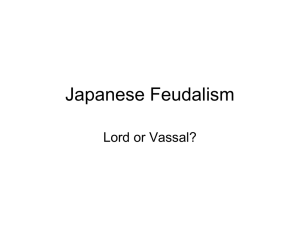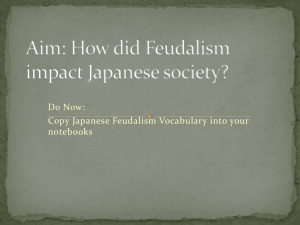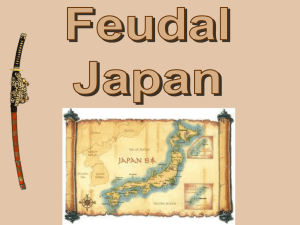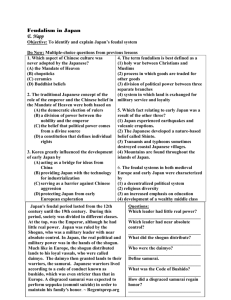Feudal Japan - sheridanhistory
advertisement
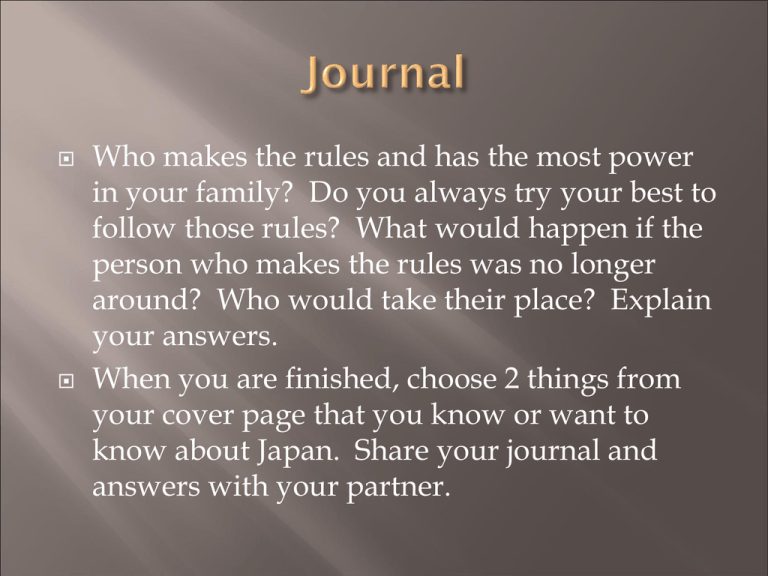
Who makes the rules and has the most power in your family? Do you always try your best to follow those rules? What would happen if the person who makes the rules was no longer around? Who would take their place? Explain your answers. When you are finished, choose 2 things from your cover page that you know or want to know about Japan. Share your journal and answers with your partner. Prince Shotoku Shogun Daimyo Samurai Bushido Feudalism Noh drama Tokugawa Ieyasu Regent Haiku The people of Japan were broken up into different classes or groups. The Emperor, the Shogun and Daimyo, the Samurai, the peasants and artisans, and the merchants. One way to help you remember some of the groups in Japan is the acronym SPAM – Samurai, Peasants, Artisans, and Merchants. Emperor Shogun/ Daimyo Samurai Peasants and Artisans Merchants The classes were set up like a triangle with the emperor on top and the merchants on the bottom – with everyone else in between. The Emperor was the ruler at the top of Japanese society but he had very little real power. The Shogun was the most important daimyo (large land owner) and was the actual ruler of Japan. The Shogun were warlords – the name Shogun means, “Great General”. The Daimyo were land owning nobility. They needed a small army of Samurai to protect the peasants who lived on their land. The Samurai were the warriors of Japan. They were members of a trained army of fighters that were loyal to the daimyo. Samurai means, “those who serve”. They developed a code of conduct called Bushido. Known as the way of the warrior, bushido focused on doing your duty no matter what the cost. Loyalty, courage, respect, honesty, integrity, and honor were the most important things for a Samurai. Often samurai would rather kill themselves than face dishonor – either from defeat on the battle field or embarrassing their daimyo. If a samurai did embarrass or fail his daimyo he would kill himself in a ritual called seppuku or harakiri – which involved cutting open your own stomach with a knife. The peasants and artisans made up the largest class in Feudal Japan. Peasants often grew food while artisans made special crafts like pottery or swords. Unlike peasants and artisans, merchants produced no goods that contributed to society. They just sold items from one group to the other. These classes make up something called the Feudal System. A social system in which lords grant people land or other rewards in exchange for service. Peasants work the land of the Daimyo and the Daimyo protected peasants with the Samurai. All of these classes played important roles in Japanese society. This feudal system based on military power lasted for hundreds of years. Eventually, in the mid 1800’s during the Meiji restoration this system came to an end, but the beliefs and code of the samurai still influence Japanese society to this very day. What do you think of when you hear the word culture? If you wanted to describe features of today’s American culture, what would you talk about? 1. What would you see and hear at a Noh drama? What is the mood of a Noh drama? 2. Where did the Japanese display their art? Why do you think art was displayed there? 3. What do “The Tale of Genji” and “The Pillow Book” have in common? How are they different? 4. How did the Japanese writing system become different from the Chinese system? 5. How did women help develop a true Japanese literature? 6. How would you describe the nobles at the emperor’s court? A Haiku is an unrhymed Japanese poem of 3 lines containing 17 syllables, 5,7,and 5. It is usually light and delicate in feeling and is concerned with something lovely in nature. Examples: An old silent pond… A frog jumps into the pond Splash! Silence again. Loud, crashing thunder And then the rain pouring down The rainbow appears

